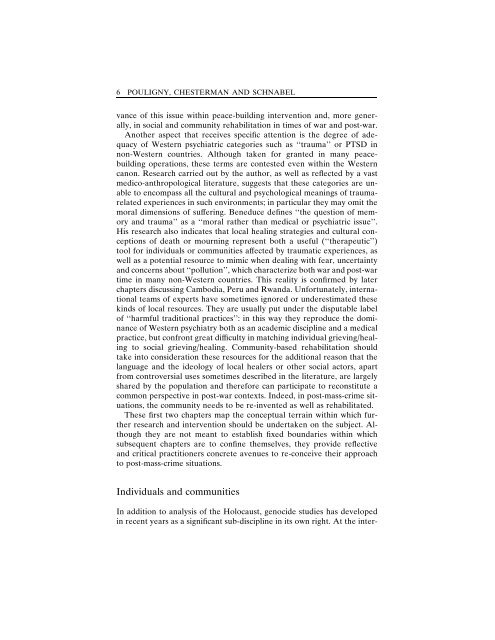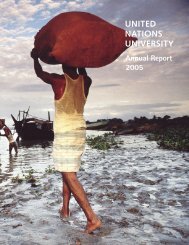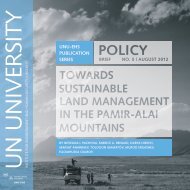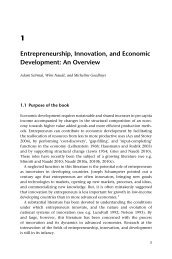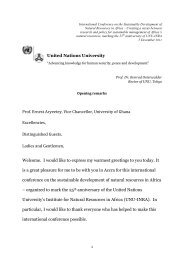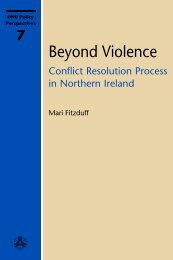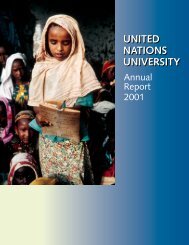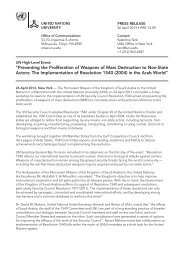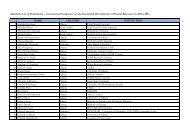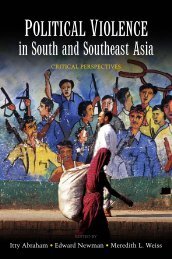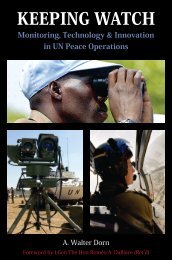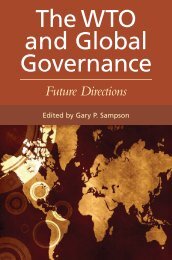After mass crime: Rebuilding states and communities
After mass crime: Rebuilding states and communities
After mass crime: Rebuilding states and communities
You also want an ePaper? Increase the reach of your titles
YUMPU automatically turns print PDFs into web optimized ePapers that Google loves.
6 POULIGNY, CHESTERMAN AND SCHNABELvance of this issue within peace-building intervention <strong>and</strong>, more generally,in social <strong>and</strong> community rehabilitation in times of war <strong>and</strong> post-war.Another aspect that receives specific attention is the degree of adequacyof Western psychiatric categories such as ‘‘trauma’’ or PTSD innon-Western countries. Although taken for granted in many peacebuildingoperations, these terms are contested even within the Westerncanon. Research carried out by the author, as well as reflected by a vastmedico-anthropological literature, suggests that these categories are unableto encompass all the cultural <strong>and</strong> psychological meanings of traumarelatedexperiences in such environments; in particular they may omit themoral dimensions of suffering. Beneduce defines ‘‘the question of memory<strong>and</strong> trauma’’ as a ‘‘moral rather than medical or psychiatric issue’’.His research also indicates that local healing strategies <strong>and</strong> cultural conceptionsof death or mourning represent both a useful (‘‘therapeutic’’)tool for individuals or <strong>communities</strong> affected by traumatic experiences, aswell as a potential resource to mimic when dealing with fear, uncertainty<strong>and</strong> concerns about ‘‘pollution’’, which characterize both war <strong>and</strong> post-wartime in many non-Western countries. This reality is confirmed by laterchapters discussing Cambodia, Peru <strong>and</strong> Rw<strong>and</strong>a. Unfortunately, internationalteams of experts have sometimes ignored or underestimated thesekinds of local resources. They are usually put under the disputable labelof ‘‘harmful traditional practices’’: in this way they reproduce the dominanceof Western psychiatry both as an academic discipline <strong>and</strong> a medicalpractice, but confront great difficulty in matching individual grieving/healingto social grieving/healing. Community-based rehabilitation shouldtake into consideration these resources for the additional reason that thelanguage <strong>and</strong> the ideology of local healers or other social actors, apartfrom controversial uses sometimes described in the literature, are largelyshared by the population <strong>and</strong> therefore can participate to reconstitute acommon perspective in post-war contexts. Indeed, in post-<strong>mass</strong>-<strong>crime</strong> situations,the community needs to be re-invented as well as rehabilitated.These first two chapters map the conceptual terrain within which furtherresearch <strong>and</strong> intervention should be undertaken on the subject. Althoughthey are not meant to establish fixed boundaries within whichsubsequent chapters are to confine themselves, they provide reflective<strong>and</strong> critical practitioners concrete avenues to re-conceive their approachto post-<strong>mass</strong>-<strong>crime</strong> situations.Individuals <strong>and</strong> <strong>communities</strong>In addition to analysis of the Holocaust, genocide studies has developedin recent years as a significant sub-discipline in its own right. At the inter-


